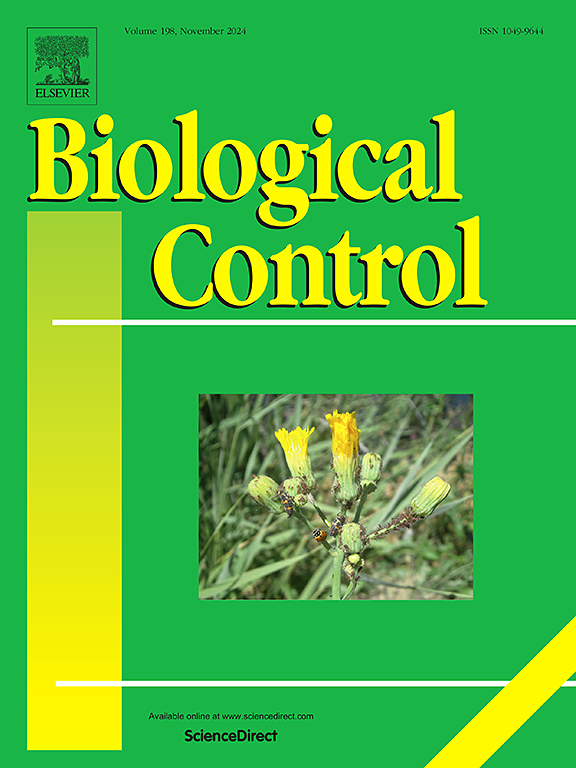不同的人工光照光谱改变了多面手捕食者Orius insidiosus (Say)的交配行为,光周期延长促进了其发育
IF 3.4
2区 农林科学
Q2 BIOTECHNOLOGY & APPLIED MICROBIOLOGY
引用次数: 0
摘要
在温室和室内农业等保护性种植系统中,增强型生物防治取决于天敌的释放率、建立和繁殖。在这些系统中,发光二极管(led)被广泛用于促进植物生长,并越来越多地应用于天敌的大规模饲养设施中。然而,led对有益捕食者生命周期的影响仍未得到充分探索。本文研究了广谱捕食者隐孔孔蝽(Orius insidiosus)在捕食西方蓟马(Frankliniella occidentalis)的光谱下的交配行为和发育表现。在实验室实验中,捕食者对暴露在人工光序列中,从模拟多云冬日的12小时基线太阳光照条件开始,辅以8小时光周期延长(蓝色、蓝红或蓝绿红光谱),或不延长的对照。在所有测试条件下,交配都发生了,但蓝光降低了交配的频率和持续时间。光周期延长提高了黄颡鱼的繁殖力和育性,第二代成虫数量最多,蓝光有利于产卵和孵化,但不利于成虫的变态。第二代性别比不受光照序列的影响,保持种群活力,雌性比例平衡。本研究结果表明,在人工光照条件下,暗纹夜蛾可以成功交配、繁殖和发育,并强调了调节光谱在优化保护作物的大规模饲养和建立方面的潜力。本文章由计算机程序翻译,如有差异,请以英文原文为准。
Different artificial lighting spectra changes the mating behavior of the generalist predator Orius insidiosus (Say), and photoperiod extension promotes its development
In protected cropping systems such as greenhouses and indoor farming, augmentative biological control depends on release rates, establishment, and reproduction of natural enemies. Light-emitting diodes (LEDs) are widely used to enhance plant growth in these systems and are increasingly implemented in mass-rearing facilities for natural enemies. However, the impacts of LEDs on the life cycle of beneficial predators remain insufficiently explored. This study examined the mating behaviors and developmental performance of generalist predator Orius insidiosus under light spectra previously shown to support its predation of the pest thrips Frankliniella occidentalis. In laboratory experiments, predator pairs were exposed to artificial light sequences starting with a 12 h baseline solar light condition simulating a cloudy winter day, supplemented by 8 h photoperiod extensions (blue, blue-red, or blue-green–red spectra), or a control without extension. Mating occurred under all tested conditions, but blue light reduced mating frequency and duration. Photoperiod extension improved fecundity, fertility, and resulted in the highest number of second-generation O. insidiosus adults, with blue light favoring egg laying and hatching but not metamorphosis into adults. The second-generation sex ratio was unaffected by light sequence, maintaining population viability with a balanced proportion of females. Our findings demonstrate that O. insidiosus can successfully mate, reproduce, and develop under artificial lighting and highlight the potential of modulating light spectrum to optimize both mass-rearing and establishment in protected crops.
求助全文
通过发布文献求助,成功后即可免费获取论文全文。
去求助
来源期刊

Biological Control
生物-昆虫学
CiteScore
7.40
自引率
7.10%
发文量
220
审稿时长
63 days
期刊介绍:
Biological control is an environmentally sound and effective means of reducing or mitigating pests and pest effects through the use of natural enemies. The aim of Biological Control is to promote this science and technology through publication of original research articles and reviews of research and theory. The journal devotes a section to reports on biotechnologies dealing with the elucidation and use of genes or gene products for the enhancement of biological control agents.
The journal encompasses biological control of viral, microbial, nematode, insect, mite, weed, and vertebrate pests in agriculture, aquatic, forest, natural resource, stored product, and urban environments. Biological control of arthropod pests of human and domestic animals is also included. Ecological, molecular, and biotechnological approaches to the understanding of biological control are welcome.
 求助内容:
求助内容: 应助结果提醒方式:
应助结果提醒方式:


